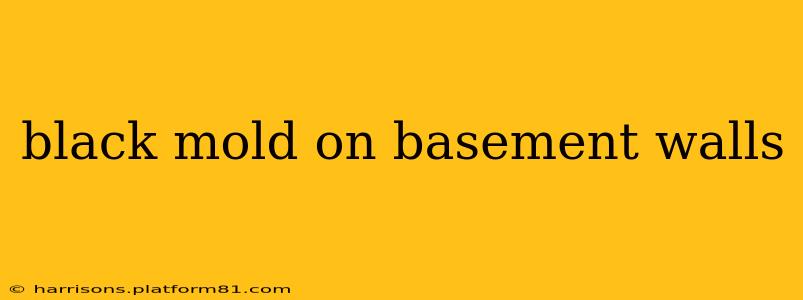Discovering black mold on your basement walls is a serious concern, demanding immediate attention. Black mold, often Stachybotrys chartarum, but also other species, can pose significant health risks if left untreated. This comprehensive guide will walk you through identifying, removing, and preventing black mold growth in your basement.
What Does Black Mold Look like on Basement Walls?
Black mold isn't always jet black; it can range in color from dark green, brown, or even gray. It often appears slimy or velvety in texture and might have a musty odor. Crucially, visual identification alone isn't definitive. Many other fungi can resemble black mold. Therefore, it’s vital to confirm its identity through professional testing if you suspect a problem.
Is Black Mold on Basement Walls Dangerous?
Yes, certain types of mold, including some species of black mold, can produce mycotoxins—harmful substances that can cause a range of health problems. These problems can vary from mild allergy symptoms like sneezing and coughing to more serious respiratory issues, particularly in vulnerable populations like children, the elderly, and individuals with pre-existing respiratory conditions. The severity of the health risks depends on factors like the type of mold, the extent of the infestation, and individual sensitivities.
How Does Black Mold Get on Basement Walls?
Basements are prone to mold growth due to several factors:
- High Humidity: Dampness is a breeding ground for mold. Leaks, condensation, and poor ventilation all contribute to high humidity levels.
- Water Damage: Leaks from pipes, overflowing drains, or even seepage through cracks in the foundation create ideal conditions for mold to thrive.
- Poor Ventilation: Lack of proper ventilation traps moisture, preventing it from escaping and increasing the likelihood of mold growth.
- Organic Materials: Mold feeds on organic matter. Wood, drywall, insulation, and even dust particles provide food sources for mold spores.
How to Remove Black Mold from Basement Walls?
Warning: Attempting to remove extensive black mold infestations yourself can be dangerous due to the potential for inhaling spores and mycotoxins. For large infestations, always contact a qualified mold remediation specialist. They have the expertise, equipment, and safety protocols to handle the job safely and effectively.
For small, isolated patches (less than 10 square feet), you can attempt removal yourself, but follow these safety precautions:
- Protect Yourself: Wear an N95 respirator mask, gloves, and protective eyewear.
- Contain the Area: Isolate the affected area to prevent spore dispersal.
- Prepare the Area: Remove loose or damaged materials.
- Clean the Area: Use a solution of one cup of bleach to one gallon of water. Apply the solution to the affected area and scrub thoroughly. Allow it to sit for 10 minutes, then scrub again. Rinse thoroughly with clean water.
- Dry the Area: Ensure the area is completely dry before replacing any materials.
Never use a shop vac to clean up mold. This can spread spores further.
How to Prevent Black Mold on Basement Walls?
Preventing mold growth is far more effective and less expensive than remediation. Consider these preventative measures:
- Improve Ventilation: Install exhaust fans or a dehumidifier to reduce humidity levels.
- Address Water Leaks: Repair any leaks promptly to eliminate moisture sources.
- Maintain Dry Conditions: Regularly inspect your basement for signs of moisture.
- Seal Cracks: Caulk or seal any cracks in your foundation to prevent water seepage.
- Regular Cleaning: Regularly clean and disinfect your basement to remove dust and debris that mold feeds on.
What are the Health Effects of Black Mold Exposure?
Exposure to black mold can trigger various health problems, ranging in severity. Mild symptoms may include allergic reactions such as sneezing, coughing, itchy eyes, and skin rashes. More severe reactions can manifest as respiratory issues like asthma exacerbations, bronchitis, or even hypersensitivity pneumonitis (a lung inflammation). In rare cases, more serious health complications are possible, emphasizing the importance of prompt detection and remediation.
How Much Does Black Mold Removal Cost?
The cost of black mold removal varies greatly depending on the extent of the infestation, the location, and the remediation methods required. Small, localized areas might be addressed for a few hundred dollars, while large-scale infestations can cost thousands, even tens of thousands, of dollars. Always obtain multiple quotes from reputable mold remediation companies before making a decision.
This information is for general knowledge and does not constitute professional advice. Always consult with a qualified mold remediation specialist for accurate diagnosis and treatment of black mold infestations in your home.
